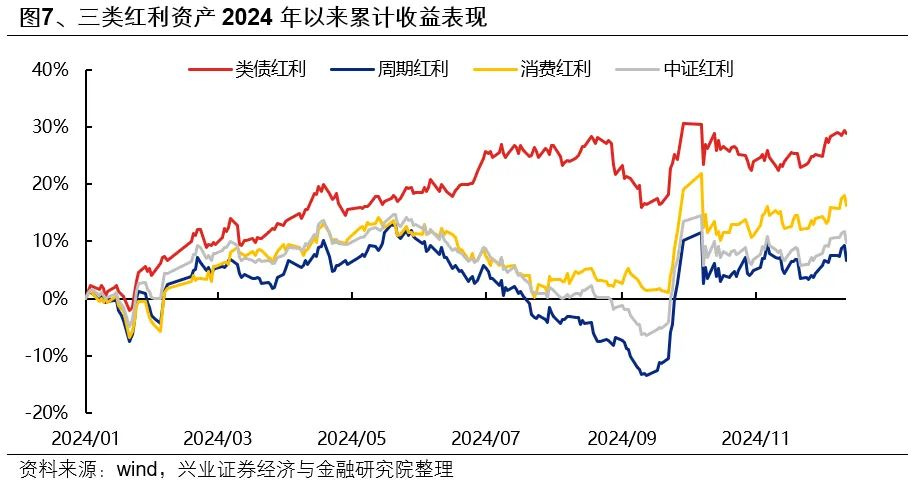Are investors aware of the impressive gains achieved by China’s banks, telcos, and energy stocks in 2024? These sectors share a notable commonality: high dividend yields.
For example, while the MSCI China Index delivered a respectable return of nearly 20% in 2024, the Dividend ETF we highlighted in a previous post outperformed significantly, returning over 40%!
2024 was undoubtedly a stellar year for dividend investing in China.
But it doesn’t stop there. Investors who stuck to dividend stocks in China via the ETF would have achieved a total return of 54.2% since 2012, compared to the MSCI China’s disappointing -2.4% loss over the same period. Clearly, focusing on dividend-paying stocks can make a world of difference when investing in China.
China Industrial Securities (CIS) has also taken note of this trend and developed a set of dividend stock screening criteria that could be highly beneficial for investors. The rules are straightforward:
Three-Year Correlation with 30-Year Government Bond Yield: The correlation coefficient between the stock price and the 30-year government bond yield must be less than -0.8.
Market Capitalization: The company must have a total market cap exceeding 10 billion RMB.
Dividend Yield: The stock’s dividend yield must be greater than 2%.
Maximum Drawdown: The stock’s maximum drawdown over the past five years should be less than 30%.
Industry Focus: Stocks are primarily concentrated in industries like banking, transportation, telecoms, and electricity.
Rationale Behind the Criteria:
Defensive Nature (Rule 1): Stocks with prices that move inversely to bond yields exhibit bond-like defensiveness, making them less susceptible to market volatility.
Large Market Capitalization (Rule 2): Ensures the companies are well-established and not penny stocks, providing more stability.
Dividend Yield (Rule 3): A minimum yield of 2% might seem modest, but it’s significant in the context of China, where deposit interest rates are at 0.35%.
Low Volatility (Rule 4): Limiting drawdowns to 30% offers relative stability compared to the CSI300, which saw a 40% decline from its 2021 peak to 2024 lows.
Critical Industries (Rule 5): Focusing on infrastructure and utility stocks essential to the country's functioning ensures resilience and consistent cash flow, further strengthening their defensive characteristics.
These criteria are designed to identify blue-chip companies with low volatility and reasonable dividend yields that outpace inflation—essentially, bond-like stocks. This approach allows investors to navigate the ongoing fluctuations in the Chinese stock market while maintaining a steady cash flow.
In 2024, applying these selection criteria would have resulted in a less volatile yet higher-performing portfolio, as illustrated by the red line in the chart below:
Legend for the Chart:
Red Line: Bond-like dividend-paying stocks (e.g., utilities, transportation, banks, etc.), selected based on the criteria outlined above.
Blue Line: Cyclical dividend-paying stocks (e.g., coal, steel, etc.).
Yellow Line: Consumption dividend-paying stocks (e.g., textiles, automobiles, household appliances, etc.).
Grey Line: CSI Dividend Stock Index (a benchmark representing general dividend-paying stocks in China).
The chart demonstrates how the bond-like dividend-bearing stocks (red line) exhibited lower volatility and higher returns compared to other dividend stock categories and the broader CSI Dividend Stock Index in 2024.
Below is a table of stocks identified by CIS using the screening rules:
While the original screening rules have worked well for the Chinese A-share market, we want to take it a step further by applying similar rules to the Hong Kong stock market. This approach caters to foreign investors, who often feel more comfortable buying China stocks listed in Hong Kong rather than directly venturing into the A-share market.
Additionally, recognizing that a dividend yield of 2% might seem insufficient for foreign investors, we have increased the threshold to 5% or higher to make the selection more attractive.
Below is a list of HK-listed stocks that meet these criteria:
Market cap more than US$1,300m
Dividend yield minimally at 5%
‘Infrastructure’ industries like utilities, transportation, banks etc





